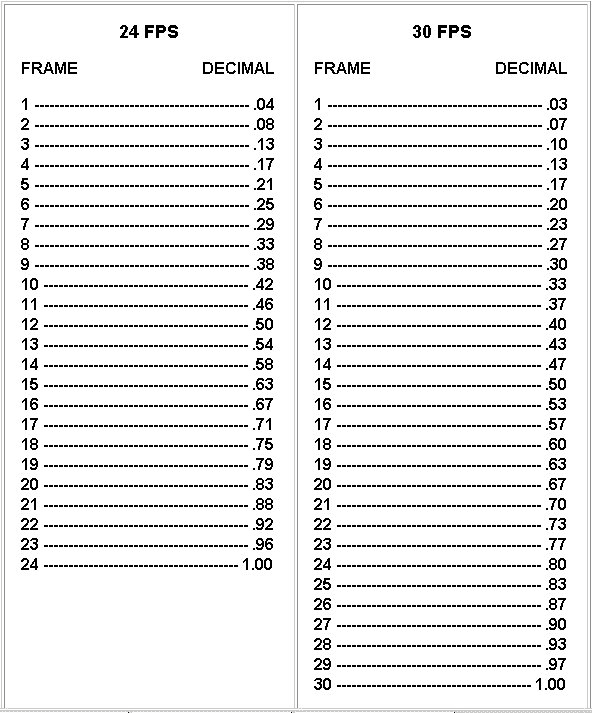|
Instructions:
Use
this accurate free stopwatch to time the events you wish to
animate. Begin by typing in the framerate
you desire in the F.P.S. (Frames Per Second) box.
Once this is done you can time any action (like the bouncing of a
ball) using the Start/Stop button. The result will
display how many Seconds the action took and the
number of Frames that you must use to animate the
timed action at the selected frame-rate. To start
over, be sure to push re-set to
Zero-out.
Even
though this is maybe convenient as an online animation aid; it is
better that you have a Stopwatch
in your hand to time actions, movements &
motion. You convert elapsed minutes into total seconds, then
multiply that by Frame Per Second
rate, either, 24Fps,
25Fps, or 30Fps (video in USA).
Or you can make FPS to Decimal breakdown of frames, reference
Charts.
___________________________________________
Real easy one: Minutes to
Frames
First convert minutes to seconds,
example: 2 minutes x 60 seconds = 120 seconds, then
....
For 24-fps, 120 seconds x
24 = 2880 Frames (= 2 minutes of time)
For 30-fps, 120 seconds x
30 = 3600 Frames (= 2 minutes of time)
If you want to know
fractional-decimal parts that
is less than
One second, then use our
handy-dandy Frames to Decimal
chart which you will see, as you scroll
down.
___________________________________________
Converting FPS to other FPS
Converting 24-fps to
30-fps, example: 12 frames
(@ 24-fps) to 30-fps
rate
....
 12 frames
X 1.25 = 15 frames, which is 1/2 second
of time @ 30-fps 12 frames
X 1.25 = 15 frames, which is 1/2 second
of time @ 30-fps
Converting 30-fps to
24-fps, example: 15 frames
(@ 30-fps) to 24-fps
rate
....
 15 frames
X .80 = 12 frames, which is 1/2 second @
24-fps 15 frames
X .80 = 12 frames, which is 1/2 second @
24-fps
Converting 25-fps to
30-fps, example: 13 frames
(@ 25-fps) to 30-fps
rate
....
 13
frames X 1.2 = 15.6 frames or about 16 frames
(rounded-off), which is
close to 1/2 13
frames X 1.2 = 15.6 frames or about 16 frames
(rounded-off), which is
close to 1/2  second @ 30-fps second @ 30-fps
___________________________________________
Every Animator
needs to use a
STOP-WATCH
Frames TO
Decimal Fractions of up to One
Second when using STOP-WATCH. Let's say your
digital Stop-watch says, 1.34 seconds. We know that 1 second is
either 24 frames or 30 frames (whichever frame rate you are using). So for the
.34, you would look at 24 FPS chart below and we can see that .34 is close
to .33 = 8 frames, and so, 1.34 seconds would be
about 24 frames + 8 frames = Total 32
frames @ 24-fps. In the 30 FPS chart, you see that .34 is close
to .33 = 10 frames, and so, 1.34 seconds would be
about 30 frames + 10 frames = Total 40
frames @ 30-fps.
I did not do
a 25 FPS chart. Easy to calculate and make. Example: 5
frames ÷ 25-fps = .20
You do that formula for each
frame ( 1, 2, 3, 4, 5, 6..... ), up to 25
frames ( = 1 second). Round off to TWO decimal
places, as you see in below
charts.

Click: Another animation chart /
aid
___________________________________________
The 'Metronome': A valuable tool for
Animators
Converting Metronome Beat
Numbers to Number of
Frames @ 24-fps, example: We want to know the number of frames at
the Metronome Beat "# 120" setting ....
 A) Establish
the constant divisor factor, 60 seconds
x 24-fps = 1440 (frames) A) Establish
the constant divisor factor, 60 seconds
x 24-fps = 1440 (frames)
 B)
1440 ÷ 120 (metronome beat #) = 12 Frames
@ 120 Beat
# B)
1440 ÷ 120 (metronome beat #) = 12 Frames
@ 120 Beat
#
When you set the Metronome to #120, the
time-space between the
tick sounds is
exactly 12 frames (1/2 second), which for example, @
12
frames per
step/stride, can ----be the
pace of a brisk animated walk. You can audibly
hear the
timing which
helps ----you
learn, feel and sense the timing,
quicker.
Converting Metronome Beat
Numbers to Number of
Frames @ 30-fps, example: We want to know the number of frames at
the Metronome Beat "# 120" setting ....
 A) Establish
the constant devisor factor, 60 seconds
x 30-fps = 1800 (frames) A) Establish
the constant devisor factor, 60 seconds
x 30-fps = 1800 (frames)
 B)
1800 ÷ 120 (metronome beat #) = 15 Frames
@ 120 Beat
# B)
1800 ÷ 120 (metronome beat #) = 15 Frames
@ 120 Beat
#
For 25-fps,same Metronome to Frames formula by first
establishing the divisor factor
.....
60 seconds x 25-fps = 1500 (frames), and so on (you know what to
do).
Using above
very simple formulas, you need to ROUND OFF decimal fractions. If
decimal fraction is 5 or more, you go up the next whole number. If it's less than 5 you stay with existing whole number. Examples: 10.22 is rounded off to 10, but
10.55 is rounded off to 11. Get it? If not, take basic math
refresher course.
So, you're too lazy to
do the simple math to make your Metronome
Beats to Frames Chart?
CLICK
HERE
Brought to you
by Stop Motion Works™
|